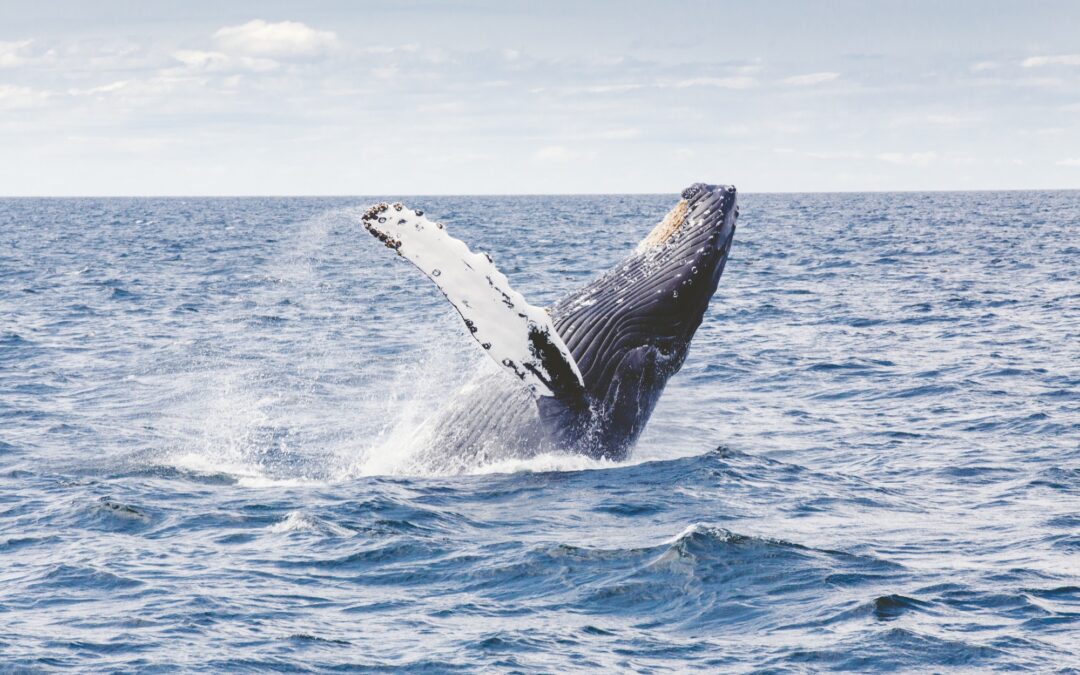Did you know that the Monarch butterfly can cycle through up to five generations in one year’s migration?
At the opposite end of the spectrum, North Pacific humpback whales complete the same migration every year of their lives. That means the oldest among them could make the same journey 50 times or more!
Why do animals migrate?
One of the most common reasons is to find food or a better climate. With humpback whales, there’s even more involved. Their migration patterns are vital to their survival as a species.
Here’s how humpback whale migration works, and why they move across the planet to visit Hawaii every year.
Spending Summer in Alaskan Waters
Humpback whales start their journeys in the northern Pacific ocean. The highest concentration of whales live in Alaska’s waters. But many can also be found in the seas around western Canada and eastern Russia.
Humpback whales spend the warmer months of the year there, typically from June to October.
These seas are rich in the whales’ favorite foods. These include krill, which are small crustaceans, and small fish.
As winter approaches, the whales begin their migration.
The Migration
There are three areas that are popular for north pacific humpback whales to migrate to. These are:
- Hawaiian islands
- Southern Japanese islands
- Mexico
However, the majority – 60% in fact – choose to head to Hawaii. Of these three destinations, Hawaii is the closest. Therefore it requires the shortest migration.
Some humpback whales have been known to migrate up to 8,000 kilometers each way. But most stick to the 5,000-kilometer trip to the Hawaiian islands.
This journey takes the whales anywhere between 5 and 8 weeks. They swim almost constantly at speeds of 5-8 kilometers per hour. This slow but steady approach helps the whales travel up to 150 kilometers a day!
Each year, an estimated 10,000 humpback whales make this journey. But it’s not just for food or climate.
In fact, humpback whales won’t eat for the up to six months that they stay in Hawaii’s waters. They survive off of the fat reserves they built up over the other six months they spent in the northern seas.
The reason they migrate is all about breeding.
Migrating to Safer Seas
Humpback whales choose to live in Hawaii for the winter months to breed and birth their young. Why do they choose these waters?
Several factors contribute to their migration. These include the variety of depths in the seas around Hawaii and its salinity and visibility. But the number one reason is the lack of predators.
Hawaiian waters have almost no food that is suited to humpback whales. As we said, they don’t eat for the months they’re there. Difficult as that may be, it means that no similar animals are inhabiting the waters.
In the northern Pacific, the abundance of krill and small fish attract other large marine life, such as killer whales. If a humpback whale were to nurse its calves in these waters, the calves would be easy prey for the orcas. So instead, humpback whales migrate to safer waters.
Marine life like Galapagos sharks and Mahi Mahi do inhabit these waters. But there’s nothing that poses a real threat to humpback whales.
Trickle Migration
Instead of traveling all at once, North Pacific humpback migration happens in waves. Over the early winter months, the whales trickle in in five groups.
First, mothers who are still nursing their young arrive.
Then come mothers with older calves. They journey together to teach their young the migration. At the end of this journey, these young are usually weaned.
The third group is adult males. These are followed by adult females who are not nursing or pregnant.
The final group is pregnant females. A humpback whale’s gestation period is between 11-12 months. So they return to Hawaii to birth the young that were conceived the previous winter.
Humpback Whales in Hawaii
Humpback whales have long been important to Hawaii. Their reliable migration every single year had a significant impact on Hawaiian culture.
For example, the Hawaiian ocean god Kanaloa’s animal form is a humpback whale. The creatures have also been viewed as guardians of those who live on the islands.
But how do the animals spend their months on the Hawaiian coast?
Breeding in Hawaii
The primary reason for humpback migration is breeding and the nursing of their young.
Humpbacks are polygynous. That means that a male will impregnate several females. This of course leads to competition between the males.
Males don’t stay with an impregnated female on the migration home. They also don’t play any role in nursing the young. But once conception has taken place, a male will protect the female while she is still in Hawaii.
Humpback Behavior in Hawaii
Even though humpback whales don’t feed while in Hawaii, they are very active. As the animals can’t breathe underwater, they come to the surface every 7-20 minutes. And it’s very exciting when they do!
They are often seen breaching the water, in what scientists believe is communication. This is the behavior that tourists travel thousands of kilometers to see.
There are eight common surface humpback behaviors whale watchers can usually spot. They are as follows.
1. Blow
When a whale comes to the surface to breathe, it blows out a spout high into the air. This is one of the easiest ways to spot a whale near the surface from a distance.
2. Head Rise
The whale lifts just its head out of the water. This may be for the whale to look around, or for communication.
3. Head Lunge
Like the head rise but more aggressive, the whale will launch its head out of the water. This is one example of competitive behavior between males.
4. Pec Slap
Humpback whales have the longest flipper of any cetacean. And they’re used for above-water displays as well as swimming.
In a pec slap, a whale will slap the surface of the water. This is most likely for communication.
5. Tail Slap
Humpbacks also bring their tail out of the water to slap the surface. This often happens several times in a row. It is likely used as a warning.
6. Peduncle Slap
This is similar to the tail slap but more excitable! More of the whale’s body comes out of the water and is visible to whale watchers.
7. Fluke Up Dive
A whale brings its tail above the water to help it dive down deeper after coming up for air. It’s a slower motion than the tail slap.
8. Breaching
Perhaps the most famous humpback behavior is when a whale breaches the surface. It uses its tail to throw almost its entire body out of the water. Scientists think this may be to communicate over longer distances.
The Best Way to Watch Whale Acrobatics
Humpbacks are so large that their surface behavior can be seen from quite a distance. There are many areas on the island popular with whale watchers for this very reason. It’s not uncommon to see people on the side of the road waiting with binoculars in hand.
Depending on where you are on the Hawaiian islands, sightings will be more or less common. But the most surefire way to spot a whale is to get into the ocean. Whale-watching safaris can get you within a hundred meters of a breaching whale!
Humpback Singing in Hawaii
Humpback whales are also known for their powerful singing voices. The whales sing songs that are between 10-20 minutes long, sometimes on repeat for hours!
What’s most fascinating is that all humpbacks seem to sing the same song. And it changes a little every year.
Scientists are yet to confirm the reason for humpback singing. However, one common theory is that it’s related to breeding. This is especially plausible because only male whales sing.
Best of all, you don’t need any special equipment to hear their songs! While you’re swimming in the ocean, unblock your ears and listen closely. You’ll likely hear a whale song nearby.
Health of the Population
As spring turns into summer, the whales head back to the northern pacific. This allows them to refuel for next year’s migration.
The 10,000 whales that make this journey every year show that the population is recovering from overfishing. In the middle of the last century, these numbers reduced to a terrifyingly low 1,000. But government and local efforts have helped to revive these numbers close to the possible 15,000 of the 19th century.
Whale tourism is one way to protect these majestic creatures. Revenue generated by whale watching tours keeps up support for whale protection. They help to ensure that whale fishing regulations stay in place.
See Whales in Hawaii
The best time to see humpback whales is during their stint in Hawaiian waters. As we explained, a good pair of binoculars can help you spot them from the coastline. But by far, the best way to see humpback whales is from the ocean.
Go Adventure Hawaii runs whale-watching safari tours that take you up close to these incredible creatures. Throughout fall, winter, and spring, we guide our guests around the coast spotting their acrobatics.
Visit our bookings page to check availability during your Hawaii vacation. We look forward to whale watching with you!

